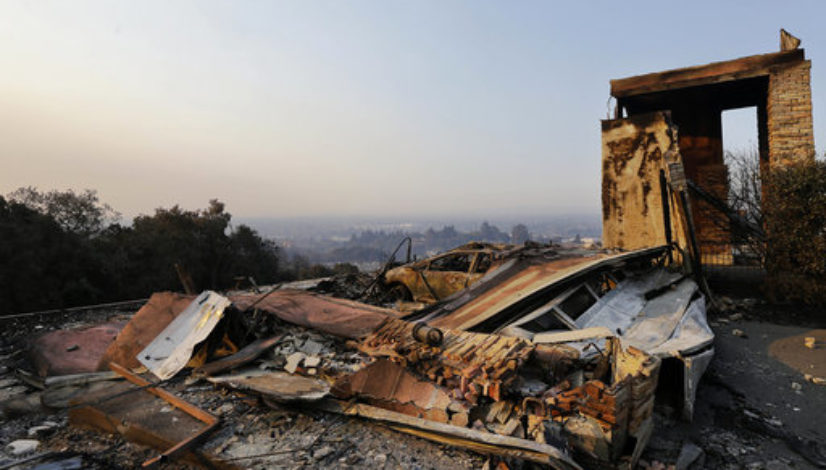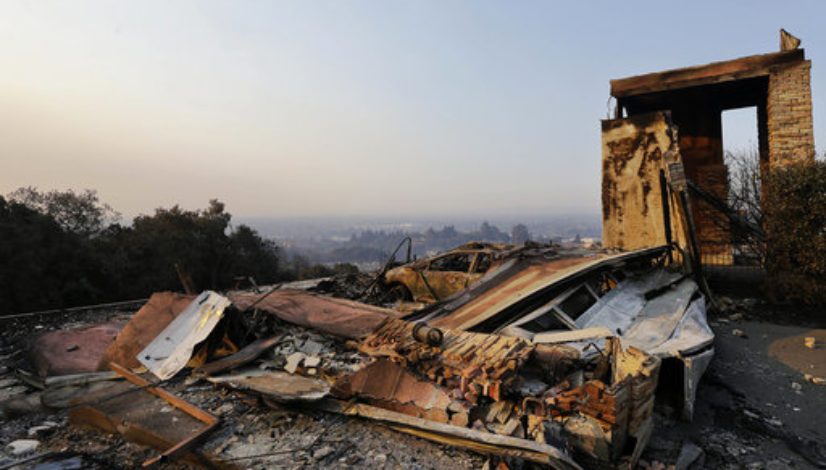California cannabis growers reeling from “most financially trying, stressful year ever”

Published: Oct 12, 2017, 2:53 pm • Updated: Oct 12, 2017, 6:55 pm
By Carole Brodsky, For The Cannifornian
“This time of year, everyone’s harvesting. And now, the annual paycheck that we’ve been working all year to earn may have been burnt to a crisp or will soon dry out due to lack of water.”
The stresses felt by cannabis farmer Ahren Osterbrink, a Redwood Valley resident evacuated since the onset of the Mendocino Lake Complex fire, are feelings mirrored by countless farmers.
This season has already been like no other for farmers like Osterbrink, who is endeavoring to become compliant with state and local regulations. Farmers have spent tens of thousands of dollars — in some cases even more — to legalize their properties and their businesses, all the while knowing that the per-pound price for the 2017 harvest may well go into free-fall. The fire has only compounded his concerns.
“I’m about as legal as you can be these days,” Osterbrink smiles.
He is a member of Mendocino Generations, an organization consisting of more than three dozen small farmers who grow outdoor, organic cannabis. The founders — Chiah Rodriques and her husband, Jamie Beatty — are Redwood Valley natives who are currently providing support for numerous farmers affected by the conflagration that swept through some of the world’s most fertile cannabis growing areas.
Related: Many farmers are ineligible for federal assistance, insurance and loans
The fire came at the peak of harvest season, with plants in many stages of production. Late-stage sativa strains, like many in Osterbrink’s garden, are mostly still in the ground, while other early flowering varieties have already been harvested and are drying and curing — a process that can take weeks.
“We have been working hard to harvest as quickly as we can and secure what we can,” says Rodriques, operations director for Mendocino Generations. The organization’s member-farmers currently hold more than a quarter of the county-issued cannabis growing permits, representing people Rodriques describes as the best of the cannabis community.
“This has been the most financially trying and stressful year ever for farmers. To add a fire with complete losses on top of it leaves me without words,” says Rodriques, whose home and farm lies near the western border of the fire. “I can’t describe the immense, tragic loss our friends and farmers are experiencing.”
At least one farmer has lost their home, dozens are evacuated and she has yet to hear from all the organization’s partners.
“Fortunately our community is strong, tightly bonded and very generous to one another. The outpouring of help and support so far has been amazing,” Rodriques said.
For the past 72 hours, Osterbrink has been tethered to his phone, dealing with extremely spotty service and trying his best to remain positive, all the while knowing his annual crop may be decimated by the time he is able to return to his garden.
“Redwood Valley is such a tight-knit community. To have this devastation is terrible,” he said.
Related stories
- Some cannabis farmers’ livelihoods could be wiped out by California fires
- California authorities arrest 18, including Rastafarian church leader, in marijuana raids at numerous sites
- Cannabis farmers accused of offering California sheriff $1M bribe
- Auditor slams California sheriff’s use of funds from cannabis permits to bust illegal grows
- Man shot, killed after confronting marijuana growers on his rural property
The Tomki Road area where Osterbrink and his family live has been devastated by the fire. Though he has been informed his house was spared, his livelihood — his cannabis crop — may not have been.
“We got awakened by a friend at about 1:30 a.m. on Monday morning. We packed what we could. I could see the fire was far enough away to get my family into a truck and send them out safely,” Osterbrink said.
He drove to the top of Tomki Road. “I could see Redwood Valley from Cave Creek. I could see the fires. It was absolutely horrible. It looked like everything from Potter to 101 was on fire.
“I had a point of view where I could see the Frey Ranch. I tried to call a friend who lives there, but I didn’t reach him.”
The flames were close enough that Osterbrink knew he had to leave, bur far enough away that he had time to think.
He made a strategic decision — one that was repeated over and over again by dozens if not hundreds of farmers through the wee hours of Monday night.
“I grabbed some bud. I was worried, and I felt like this was all I could do — grab product and hope to save it. I thought it seemed crazy to worry I would be arrested. I’m in the legal program, and I decided that police had much better things to do than pick on a guy with some cannabis in his truck.
“Tomki was already closed, so I headed north to Willits where I met my girlfriend at the Safeway parking lot. I was relieved to find that my friend I had been concerned about was there already,” he continued.
Authorities’ focus is on saving lives
As in any disaster, there have been reports that some residents were refusing to evacuate their property. It isn’t much of a leap to imagine that some were staying behind to guard their crop.
The historically clandestine nature of the cannabis industry has and will continue to pose unique problems for first responders. Some, who spoke on condition of anonymity, hoped that members of the cannabis community understand that saving lives is their primary goal.
“We don’t care what people do for a living. We don’t care if they grow cannabis. Our first job is to save you, and our second job is to make sure the people saving you can do it safely,” said one.
“Everyone I’ve spoken to is far more concerned about their friends, their family and their property. Gardens are secondary to that. In this day and age, law enforcement and the bad guys know who we are and what we do. Anyone who would value their garden over their lives is insane,” Osterbrink said.
Osterbrink’s property is safe for now, but his neighbors weren’t so lucky. “My neighbor’s house, which is 300 feet from the house I built, is gone. My next neighbor, 500 feet to the north? Gone. Five hundred feet to the west? All my friend’s homes are gone.”
With regard to his garden, Osterbrink has a good news/bad news situation. “The good news about our garden is that it’s still here. But now there’s been no water to the property for two days. Even with this act of mercy, we can’t get to our property to water.”
Osterbrink was robbed last spring, losing his entire net income. “We scraped by all year, looking forward to this harvest. We’ve been almost down to spending pocket change, and now this.”
New expenses add to worries
A few looters have been spotted with one arrest made, and Osterbrink himself reported a suspicious person to the Sheriff. “People called law enforcement in. We’re not afraid to call them anymore, and hopefully they’ll respect that and not use this against us.
“I personally know so many people who have lost everything. It’s enough to lose your house. If you’re lucky, maybe all you’ll be worrying about is people stealing your crop. If you survive that, then you’ll be worrying if you should sneak in to try and water your plants. If you don’t water, you’re risking losing everything. If you do, you risk being arrested yourself as a looter.”
He is understandably concerned about how his community rebounds from this crisis.
“With legalization, with trying to pay the associated fees, with the market bottoming out, it’s a lot to sort out. I just received my first quarterly tax bill. It’s $5,000, and I don’t know if I have a crop to pay for it.”
Osterbrink hopes the fire lines will hold.
“Things look OK but there are fires up there right now. Some neighbors have snuck in and are trying to put them out. I am really grateful for Cal Fire doing what they do, but I feel it’s been really challenging trying to get accurate information on the fire.”
Many rural residents we spoke to either did not receive the reverse 911 calls on Monday morning, had their cell phones turned off, live with limited or no connectivity or experienced almost immediate disruptions to cell service.
“If we didn’t have people honking their horns like crazy, who knows if some of our neighbors would have gotten out,” Osterbrink said. “Everyone I know got warned of the fire by a neighbor, and thank God we live in a community like this.”
Osterbrink hopes he can return to business as usual soon. He has buds drying on racks. Plants needing to be tended and harvested. Finished product ready to go to market.
“If I can’t go home, how do I get the buds properly dried? Who knows if there will be power? Life doesn’t stop. We don’t get to hit ‘pause’ during the drying and curing of our flowers.”
He also hopes that maybe dispensaries will create fundraisers to support farmers who were burned out or only able to salvage a portion of their crop. He is very concerned the fire may have dealt a death-blow to some of the most responsible farmers in the county — those who believed in and supported a regulated business model.
“Will people stick around and rebuild, or will they sell cheap to some corporate entity or a rich hipster kid who thinks he knows how to grow cannabis? We have such a good community here. I truly hope that doesn’t ever change.”
If you would like to help out the California growers affected by the fires, you can visit a crowdfunding site set up by the California Growers’ Association
.This story was first published on TheCannifornian.com
Topics: California, California legalization, commercial cultivation, farming, growing marijuana in california, northern california




